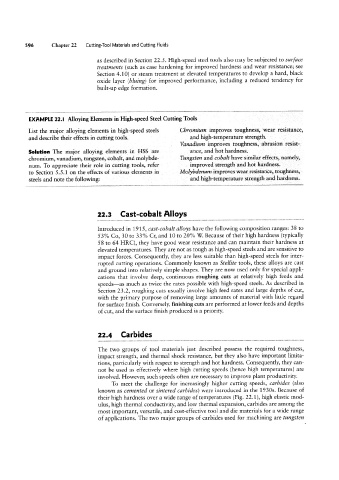Page 615 - 04. Subyek Engineering Materials - Manufacturing, Engineering and Technology SI 6th Edition - Serope Kalpakjian, Stephen Schmid (2009)
P. 615
596 Chapter 22 Cutting-Tool Materials and Cutting Fluids
as described in Section 22.5. High-speed steel tools also may be subjected to surface
treatments (such as case hardening for improved hardness and wear resistance; see
Section 4.10) or steam treatment at elevated temperatures to develop a hard, black
oxide layer (bluing) for improved performance, including a reduced tendency for
built-up edge formation.
EXAMPLE 22.| Alloying Elements in High-speed Steel Cutting Tools
List the major alloying elements in high-speed steels Chromium improves toughness, wear resistance,
and describe their effects in cutting tools. and high-temperature strength.
Vanadium improves toughness, abrasion resist-
Solution The major alloying elements in HSS are ance, and hot hardness.
chromium, vanadium, tungsten, cobalt, and molybde- Tungsten and cobalt have similar effects, namely,
num. To appreciate their role in cutting tools, refer improved strength and hot hardness.
to Section 5.5.1 on the effects of various elements in Molybdenum improves wear resistance, toughness,
steels and note the following: and high-temperature strength and hardness.
22.3 Cast-cobalt Alloys
Introduced in 1915, cast-cobalt alloys have the following composition ranges: 38 to
53% Co, 30 to 33% Cr, and 10 to 20% W. Because of their high hardness (typically
58 to 64 HRC), they have good wear resistance and can maintain their hardness at
elevated temperatures. They are not as tough as high-speed steels and are sensitive to
impact forces. Consequently, they are less suitable than high-speed steels for inter-
rupted cutting operations. Commonly known as Stellite tools, these alloys are cast
and ground into relatively simple shapes. They are now used only for special appli-
cations that involve deep, continuous roughing cuts at relatively high feeds and
speeds-as much as twice the rates possible with high-speed steels. As described in
Section 23.2, roughing cuts usually involve high feed rates and large depths of cut,
with the primary purpose of removing large amounts of material with little regard
for surface finish. Conversely, finishing cuts are performed at lower feeds and depths
of cut, and the surface finish produced is a priority.
22.4 Carbides
The two groups of tool materials just described possess the required toughness,
impact strength, and thermal shock resistance, but they also have important limita-
tions, particularly with respect to strength and hot hardness. Consequently, they can-
not be used as effectively where high cutting speeds (hence high temperatures) are
involved. However, such speeds often are necessary to improve plant productivity.
To meet the challenge for increasingly higher cutting speeds, carbides (also
known as cemented or sintered carbides) were introduced in the 1930s. Because of
their high hardness over a wide range of temperatures (Fig. 22.1), high elastic mod-
ulus, high thermal conductivity, and low thermal expansion, carbides are among the
most important, versatile, and cost-effective tool and die materials for a wide range
of applications. The two major groups of carbides used for machining are tungsten

